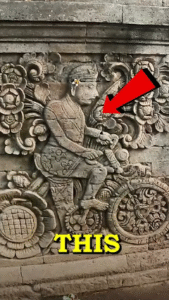In the heart of India’s ancient temple architecture lies a mystery that has intrigued many – a carving that appears to be of a modern bicycle, found on the walls of a Hindu temple. The image has sparked debates, curiosity, and theories that range from time travel to ancient advanced technology. But is it really a bicycle? Could ancient artisans have predicted future inventions? Or is there a more grounded explanation? Researcher and YouTuber Praveen Mohan, known for his explorations into ancient Indian mysteries, delves deep into this fascinating anomaly and offers some thought-provoking insights.
The Mysterious Carving
The carving in question is found in the Thousand Pillar Temple in South India, more specifically at the Hoysaleswara Temple in Halebidu, Karnataka. This temple, built in the 12th century during the rule of the Hoysala Empire, is a masterpiece of Indian temple architecture, known for its detailed sculptures and intricate carvings.
Among these carvings is a small but striking image that appears to show a man riding what looks unmistakably like a bicycle: two equal-sized wheels, a frame, a seat, and handlebars. At first glance, it’s easy to see why so many are baffled. The modern bicycle wasn’t invented until the 19th century. So how could a 12th-century temple depict one?
Theories and Speculations
The image has gone viral on social media multiple times, often accompanied by captions claiming that ancient Indians had bicycles—or even more outlandish theories suggesting time travel or alien intervention. These ideas, while imaginative, aren’t new to Indian temple discussions. Many ancient structures, such as the Kailasa temple in Ellora or the Brihadeeswarar Temple, have been points of similar speculation due to their precise construction, unexplained designs, or out-of-place artifacts.
Some believe this carving is proof of advanced knowledge possessed by ancient civilizations—knowledge we are only beginning to rediscover. Others suggest the existence of “vimanas” (mythical flying machines mentioned in ancient Indian texts) indicates the possibility of a high-tech ancient past.
But does the bicycle carving really support any of these ideas?
Praveen Mohan’s Investigation
Praveen Mohan, who has explored hundreds of temples across India and Southeast Asia, approaches the mystery with a mix of curiosity and critical thinking. In his video examining the “bicycle” carving, he brings in historical context, architecture, and the evolution of temple maintenance.
He makes a crucial observation: the temple has undergone several restorations over the centuries. Many of these renovations were done during the British colonial period in the 19th and early 20th centuries. During this time, colonial officers and Indian workers were often involved in repairing and restoring temples. In many cases, they added newer carvings to match the old ones, sometimes inserting contemporary or personal elements into the restored parts.
Mohan points out that the so-called “bicycle carving” appears to be in much better condition than surrounding carvings, suggesting it is not as old. The sharpness of the lines, the polish, and the depth of the engraving all indicate it may have been added much later than the original structure.
A Modern Addition?
One prevailing theory, which Mohan seems to support, is that the carving is a modern addition made by a sculptor or restorer during British times, likely in the late 1800s or early 1900s, when bicycles were becoming popular in India. It’s entirely possible that a local artisan, either as a form of creative expression or simply for amusement, added the bicycle-rider carving while working on restoring the temple walls.
In many Indian temples, especially during colonial times, artisans were given the freedom to replicate older styles while maintaining structural integrity. They occasionally slipped in contemporary elements, either as signatures, easter eggs, or simply for fun. There are even temples that have carvings of Europeans in hats, colonial officers, or scenes from everyday life during that period.
This practice is not unique to India. Across Europe and Asia, there are examples of religious structures where restorers or later artists inserted images of current life, technology, or even animals and gadgets from their own era.
Why It Captures Our Imagination
Despite the logical explanation, the carving continues to ignite imaginations. Perhaps it’s because it offers a tangible connection between the ancient and the modern. The idea that something so familiar as a bicycle could be found in a centuries-old temple wall is both poetic and jarring. It invites us to look at history not just through textbooks but through the eyes of curiosity.
Praveen Mohan’s work often explores the intersection of science, spirituality, and ancient architecture, encouraging people to look deeper and ask questions—but also to think critically. His videos don’t merely sensationalize these mysteries; rather, they aim to foster appreciation for ancient knowledge while seeking rational explanations.
Conclusion
So, is there really a bicycle carved into a 12th-century Hindu temple? Yes—but likely not from the 12th century. The carving, while real, is most probably a modern addition made during a restoration period, reflecting the tools, trends, and vehicles of the time.
The “bicycle in the temple” is a great example of how history, art, and human imagination collide. While it’s not evidence of ancient time travelers or lost advanced civilizations, it is a fascinating reminder of how living cultures evolve, how traditions blend with modernity, and how even ancient sacred spaces can become canvases for unexpected stories.
Thanks to researchers like Praveen Mohan, we can continue exploring these mysteries with both wonder and wisdom. Whether it’s a bike on a temple wall or a forgotten legend in a dusty manuscript, each discovery invites us to see the past not as something distant and static, but as a living, breathing tapestry—full of surprises.
